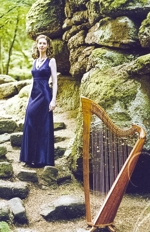Nadia
Birkenstock (Harp)
 Nadia
Birkenstock was born in Solingen in the north west of Germany.
She started playing the piano at age of five and grew up listening
to lots of classical music. Her first contact with the Celtic
harp happened when she saw the legendary Scottish harp duo "Sileas" perform,
and she instantly fell in love with the sound of the instrument
and the spirit of Celtic Music. Thanks to a scholarship she received
her first vocal training in the States (Westover School, Connecticut)
and afterwards studied voice major at the Music Conservatory
of Duesseldorf in Germany. Nadia
Birkenstock was born in Solingen in the north west of Germany.
She started playing the piano at age of five and grew up listening
to lots of classical music. Her first contact with the Celtic
harp happened when she saw the legendary Scottish harp duo "Sileas" perform,
and she instantly fell in love with the sound of the instrument
and the spirit of Celtic Music. Thanks to a scholarship she received
her first vocal training in the States (Westover School, Connecticut)
and afterwards studied voice major at the Music Conservatory
of Duesseldorf in Germany.
She taught herself to play the Celtic Harp at age 16 and attended
masterclasses for Celtic Harp with Kim Robertson (USA) and Bill
Taylor (Scotland) and others. During her vocal studies she started
her solo program for Celtic Harp and Vocals and is sucessfully
appearing in concerts at festivals, folk-clubs, concert halls,
churches, castles and other nice places in Central-Europe.
TV and radio appearances (German Television
SWR, RBB, France Musiques, Celtic
World Radio Australia and others). She also frequently plays
for the Irish Embassy in Germany. Besides her repetroire of traditional
Celtic folk songs and harp tunes, she is also successfully performing
her own songs and compositions.
In 2001 her first Solo-Album "Emerald Isles" was
released with a repertoire of celtic music and three of Nadia's
own compositions, followed by "Wandering between the Worlds" (2003)
and "Winter Tales", which will be released by LAIKA-Records in
Octobre 2006. Besides her solo appearances she also likes to duet
with Sebastian Fuhrmann (Percussion, Keyboards, Bouzouki) and the
folk group "Morris
Open".
The Celtic Harp
The Celtic Harp is one of the oldest instruments of the world and
plays a major role in the musical tradition of the Celtic countries
Ireland, Scotland and Wales.
The Celtic harp flourished in the middle ages in Scotland and especially
Ireland, where it was an aristocratic instrument and played at
king's courts and before clan chiefs. Hard times for the Celtic
harp in Ireland began around 1400 with the invasion of the English
and by 1600 not many harpers and instruments were left.
Despite several revival attempts over centuries this instrument
was almost completely forgotten and had her big renaissance only
in the 1970s. Even today the Celtic Harp (clairseach) is the national
symbol of the Irish (you can, for example, find it featured on
the back of the Irish Euro-Coins.)
Celtic harps can differ very much in size, design, way of construction,
material and sound. Since the Celtic Harp is a diatonic instrument
(no chromatic scales), many models are equipped with small levers
at the upper end of the strings, with which the strings can be
shortened and thus the tone be altered a semi-tone upwards.
The harp that Nadia mostly plays at her concerts is build by German
harp maker Frank
Sievert. (rosewood, tuning: E flat, 34 gut strings).
|
 Nadia
Birkenstock was born in Solingen in the north west of Germany.
She started playing the piano at age of five and grew up listening
to lots of classical music. Her first contact with the Celtic
harp happened when she saw the legendary Scottish harp duo "Sileas" perform,
and she instantly fell in love with the sound of the instrument
and the spirit of Celtic Music. Thanks to a scholarship she received
her first vocal training in the States (Westover School, Connecticut)
and afterwards studied voice major at the Music Conservatory
of Duesseldorf in Germany.
Nadia
Birkenstock was born in Solingen in the north west of Germany.
She started playing the piano at age of five and grew up listening
to lots of classical music. Her first contact with the Celtic
harp happened when she saw the legendary Scottish harp duo "Sileas" perform,
and she instantly fell in love with the sound of the instrument
and the spirit of Celtic Music. Thanks to a scholarship she received
her first vocal training in the States (Westover School, Connecticut)
and afterwards studied voice major at the Music Conservatory
of Duesseldorf in Germany.




